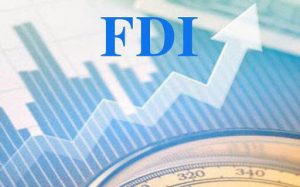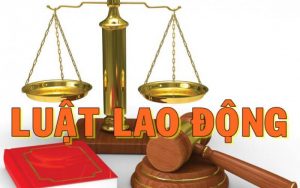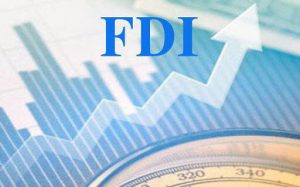
The post-COVID19 data from the Foreign Investment Agency (FIA) shows that FDI in Vietnam during 2019 continues towards growth, Vietnamese record of foreign direct investment (FDI) reached US$38.2 billion an increase of 7.2 percent as compared to the same period in 2018.Around 3,883 new projects were licensed with a total registered capital of US$362.5 billion in 2019. In 2019, foreign direct investment projects were estimated to disburse 20.38 billion USD, up 6.7 percent as compared to the same period in 2018. Out of 19 sectors receiving capital, manufacturing and processing came on top with total capital of US$24.56 billion, accounting for 65 percent of total registered investment capital. This was followed by real estate at US$3.88 billion and then by retail and wholesale. Due to COVID19 it the FDI has dropped by 8.2 percent as of the data from January-May 2020. Investment has been mainly driven by the US-China trade war.

Aside from this, Vietnam is committed to an ambitious investment plan to develop overall infrastructure in major industrial regions in the country, which would be more accessible for doing business and improve logistics. This, coupled with the recent entry into force of the Comprehensive and Progressive Agreement for Trans-Pacific Partnership (CPTPP) and the EU and Vietnam FTA (EVFTA) (ratified by Vietnam in June 2020) will provide significant opportunities for both inbound and outbound investment for the next few years. Furthermore, it is likely that Vietnam would continue towards making its legal framework to adhere to transparency requirements imposed by the aforementioned agreements, especially in relation to Intellectual Property Rights (IPR) protection
Major Sources of investment
Asian countries represent the lion’s share of FDI into Vietnam. In 2019, South Korea was the top investor in Vietnam investing US$7.9 billion, followed by Hong Kong at US$7.8 billion. In the first 11 months of 2019, the largest pledged FDI also came from Hong Kong. An important point to note is that China has been increasing its investment in Vietnam rapidly. Over the years, it has become the seventh largest investor in Vietnam. In 2018, it moved up to fifth and is now fourth. This can partly be attributed to the US-China trade war , but some analysts say that China is also pushing investment through Hong Kong as Vietnam becomes more cautious about Chinese investment.
Hanoi retains its title of being the most attractive destination for foreign investors with US$2.78 billion of total FDI registered or 16.6 percent. This is followed by Binh Duong province at US$1.25 billion. North Vietnam is rapidly consolidating its position as a main industrial hub for the electronics and heavy industry, thanks to the presence of global conglomerates like Samsung, Canon, and Foxconn and for the automotive industry (the first Vietnamese carmaker Vingroup established its factory in Haiphong last year), which are stimulating the development of a reliable supply chain in the area. Which has led to the completion of the first deep-sea port in North Vietnam, Lach Huyen port, by making its first two terminals operational, which can accommodate big vessels – thus avoiding stops to Hong Kong and Singapore in international freight transport, saving about one week in shipments.
South Vietnam has also been the main destination for renewable energy investment projects, in particular solar power plants. In the future, while the southern region will maintain its attractiveness, investments in solar plants are expected to gradually shift to the central and northern areas. Also, Binh Duong and Ho Chi Minh City are the main industrial hubs, specializing in textile, leather, footwear, mechanics, electricity and electronics, and wood processing.
Increased exports to US

As the US-China trade war continues, Vietnam has become one of the fastest growing sources of American imports in the first quarter of the 2019 and post-COVID19, China is facing major backlash, Vietnam could surpass the UK as one of the biggest suppliers to the US, according to Bloomberg. Imports from Vietnam to the US jumped 40.2 percent in the first three months over the same period of 2018. During the same time American imports of Chinese goods dropped by 13.9 percent. Following are the US import data for 2019:

Three top sectors receiving FDI
According to the FIA report, manufacturing and processing, real estate, as well as retail and wholesale are the top three sectors for FDI in Vietnam. Let’s analyze these in more details as follows:
Manufacturing and processing
Manufacturing and processing continue to account for the major portion of FDI. Vietnam’s Ministry of Trade is supporting the industry as key to boosting socio-economic development. The government wants to restructure the industry to support domestic production and increase localization rates. Industry experts say that Vietnam has benefited due to companies moving manufacturing to Vietnam as costs in China started to increase. The US-China trade war has accelerated the process.
Real estate

Vietnam’s real estate market, as in previous years, continues to attract foreign and domestic investors. Increased tourism, and large infrastructure projects, such as the Hanoi and Ho Chi Minh metros projects, are further expected to push demand for real estate. Flexible workspaces are becoming more and more common in Vietnam in part due to the limited supply of traditional offices in-demand locations. Several companies such as WeWork, Workyos, Kloud, and CEO Suites have opened co-working spaces as recent as 2018. Demand is coming from South Korea, Hong Kong, and China. While Hanoi and Ho Chi Minh City boast the highest growth, development is not confined to the main cities. Tourist spots like Da Nang, Nha Trang, and Phu Quoc island are experiencing growth spurts, with numerous hotels and residential projects under construction. The industry is also seeing strong growth due to the country’s growing middle class.
Retail and wholesale
Vietnam has one of the fastest growing middle classes regionally, fueling significant growth in the retail and wholesale sector. Its middle class is forecast to reach 33 million by 2020, up 12 million from 2012. According to a report by Deloitte, the retail and wholesale market is forecast to reach US$180 billion by 2020 – an increase of 26 percent from 2018. The government has passed several regulations since 2014, relaxing certain restrictions on foreign investors like direct participation in distribution systems, which have helped fuel its growth. For example, few FDI have become major players which include Lotte group, Vingroup, and Big C. Both local and foreign investors have been scaling up operations through various strategies, including mergers & acquisitions (M&As), franchising, and other partnership models, mostly in Hanoi and Ho Chi Minh City followed by Binh Duong, Dong Nai, and Hai Phong. These areas have experienced strong growth in supermarkets, convenience stores, commercial centers, and digital platforms. In addition, the rise of e-commerce and digital payment trends are expected to become major GDP contributors, as forecasted by the government, it will grow by 14 percent, with total revenue reaching US$484.58 billion from 2021 to 2025.
Vietnam’s continued FDI growth
Vietnam is expected to continue to maintain robust FDI investment. The country has been attracting FDI in virtually all sectors, making it an all-rounder for investors. Its challenge will be to manage its growth responsibly along with government reforms. However, as the market matures, the government has begun prioritizing ‘high-value’ FDI, such as in advanced technology and manufacturing, tourism, and high-tech farming. In addition, the government is also prioritizing adequate training for the working population to meet requirements for important sectors. As high-tech and clean sectors have less environmental impact. All in all, the US-China trade war has been working in the favor of Vietnam as many industries are shifting its manufacturing plants from China to Vietnam to take advantage of various Free trade agreements signed by Vietnam. Also, a report by DBS Bank states that Vietnam’s economy could become bigger than Singapore’s by 2029 if it sustains its growth trajectory.
HOW GPO CAN ASSIST
Hopefully, this article was helpful in your research relating to FDI in Vietnam. And we at GPO can assist you by hiring and managing an freelancer market researcher or in depth market analysis and if everything goes as per your expectations we can also assist with business legal advice for getting your business registered in Vietnam and then offer our core service of been your HR business partner in Managing your daily HR activities, as we are an HR business consultancy firm in Vietnam. So, please do share your contact details with us by clicking on this link http://hroutsourcing.gpo.vn/
Top
















